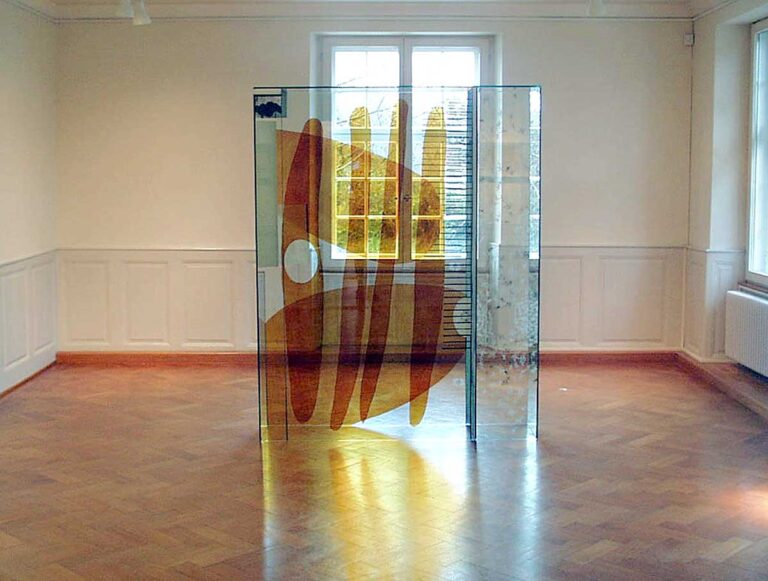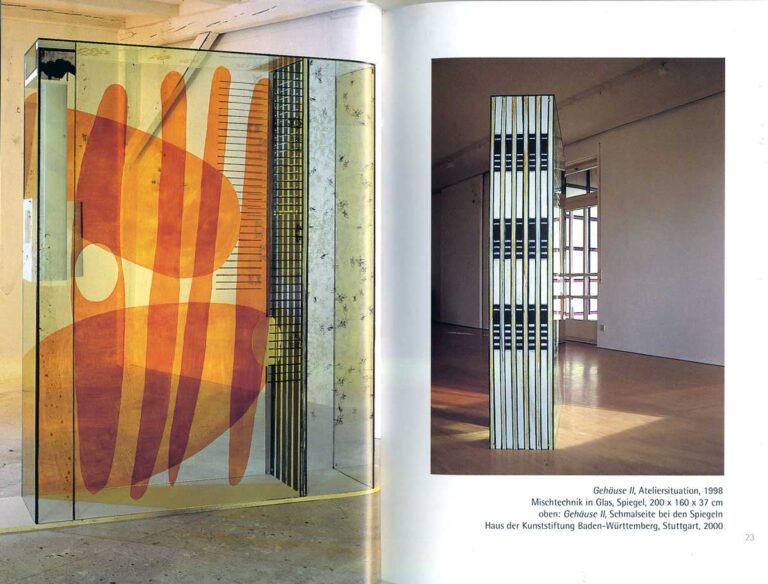



Objekt 200 x 160 x 35 cm, Floatglas 6/8mm, Spiegel, Pigment, Eisen, Siebdrucke von Handzeichnung, eingebrannt,
Silbergelb diffundiert, Mischtechnik vor/hinter ESG Glas
Object 200 x 160 x 35 cm, float glass 6/8mm, mirror, pigment, iron, silkscreen of hand drawing, burnt in, silver-yellow diffused, mixed technique on ESG glass
… monochrom quadratische oder rechteckige Farbflächen, werden von Ovalen und Kreisen unterbrochen. Die runden Öffnungen erinnern an Gucklöcher zu vergleichen an der Urform des Fotoapparates‚ die camera obscura auf. Wenn man das Gehäuse umkreist und von verschieden Blickwinkeln die Skulptur betrachtet, hat man das Gefühl, dass etwas im Kasten ist. Ständig werden neue Bilder erzeugt und durch die Materialien auch (auf Wände) projiziert, wie bei der laterna magica, dem in der Mitte des 17. Jahrhunderts entwickelten Projektionsapparats (damals für Schriften und figürliche Darstellungen). Im Gegensatz zu Gehäuse1 sind die Außenflächen von Gehäuse2 weniger von einer geometrischen Grundordnung geprägt, sondern es dominieren organische Formen im transparenten Raum, honigfarben, die an Einzeller – ein Leben im Mikrokosmos – erinnern; die im gleichen Abstand parallel angeordneten Linien als Messleiste in der Zählkammer? Wirklichkeit ist nicht geradlinig und Brechung ist Reflexion. Cristina Ohlmer zeigt uns‚ dass Sehen etwas mit Begreifen zu tun hat und somit mehr ist, als Sehen im Dienste eines linearen, rationellen und wertenden Weltbildes.
(Dr. Matthias Schrenk, Ausstellung Les Statistes III, Haus Salmegg Rheinfelden)
… The monochrome square or rectangular color surfaces are interrupted by ovals and circles: Peepholes reminding the original form of the camera, the camera obscura. When one circles the sculptural housing and looks at it from different angles, one has the feeling that something is in the box. New images are constantly being created and also projected (on wall) through the materials, as with the laterna magica, the projection apparatus developed in the middle of the 17th century (at that time for writings and figurative representations). In contrast to Gehäuse 1, the drawings of Gehäuse 2 are less geometric al, but dominated by organic forms, honey-colored, reminiscent of single-celled organisms – a life in the microcosm. Cristina Ohlmer shows us that seeing is connected to comprehension and is therefore more than seeing in the service of a linear, rational and evaluative view of the world.
(Dr. Matthias Schrenk, exhibition Les Statistes III, Haus Salmegg Rheinfelden)